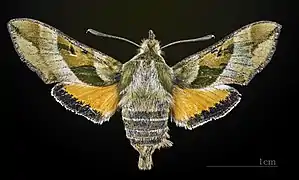Proserpinus clarkiae
Proserpinus clarkiae, or Clark's sphinx, is a moth of the family Sphingidae. The species was first described by Jean Baptiste Boisduval in 1852. It is known from British Columbia and Washington south through California to Baja California, east to Idaho, Wyoming and Utah. The habitat consists of oak woodland and pine-oak woodland in foothills.
| Clark's sphinx | |
|---|---|
.jpg.webp) | |
| Scientific classification | |
| Domain: | Eukaryota |
| Kingdom: | Animalia |
| Phylum: | Arthropoda |
| Class: | Insecta |
| Order: | Lepidoptera |
| Family: | Sphingidae |
| Genus: | Proserpinus |
| Species: | P. clarkiae |
| Binomial name | |
| Proserpinus clarkiae | |
| Synonyms | |
| |
Description
The wingspan is 30–38 mm. The forewing underside basal orange colour is vestigial or absent. The hindwing upperside is pale orange or yellowish and the marginal band of the hindwing is black.
 Female
Female Female underside
Female underside_male_dorsal.jpg.webp) Male
Male_male_ventral.jpg.webp) Male underside
Male underside
Biology
Adults are on wing from mid-March to June in one generation per year. They feed on the nectar of various flowers, including Salvia columbariae, Asclepias cordifolia, Ribes aureum, Dipterostemon capitatus, Clarkia, Vicia, Cirsium and Stachys species.
The larvae feed on Clarkia unguiculata.
References
- Boisduval, J.-A. (25 February 1852). "Lepidoptères de la Californie". Annales de la Société Entomologique de France. 10 (2): 319.
- "CATE Creating a Taxonomic eScience - Sphingidae". Cate-sphingidae.org. Archived from the original on 2012-11-05. Retrieved 2011-10-25.
External links
- Lotts, Kelly & Naberhaus, Thomas (2017). "Clark's sphinx Proserpinus clarkiae (Boisduval, 1852)". Butterflies and Moths of North America. Retrieved December 6, 2018.
- "Proserpinus clarkiae (Boisduval, 1852)". Sphingidae of the Americas. Retrieved December 6, 2018.